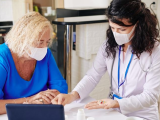(CIDRAP Business Source Osterholm Briefing) – The race is on. The next few months will pit all of our preparedness planning (or lack thereof) against a novel H1N1 virus that is certain to sweep through northern hemisphere countries.
While this next wave is not likely to dramatically increase influenza deaths—unless the virus undergoes additional mutations or reassortments—it could cause significant and sustained illness in our otherwise healthy workforce populations. And remember, we currently don't have any explicit plans to vaccinate that population, except for pregnant women and healthcare workers, even in the United States.
Regular readers of this column know I have emphasized for the past 4 months that we should expect the unexpected in our battle with this virus. But now it's time to drive a stake in the ground and declare, "No more what-ifs. This is what we can and are going to do in response to this virus in our organization over the next 4 to 6 months."
Business preparedness for this pandemic was substantially elevated this past week when the US news media suddenly found the second coming of novel H1N1. Stories about the potential shoe to drop with a fall/winter wave of illness have been everywhere.
The media's attention is not based on any recent change in the disease occurrence, but has largely occurred because of an all-out media campaign by our federal government to hit our pandemic preparedness status head-on. I applaud these federal efforts, particularly the coordinated messages coming from the Departments of Health and Human Services, Homeland Security, Education, Commerce, and Agriculture.
Despite the balanced and scientifically sound information being shared by our federal agencies, there are still a number of critics who have publicly declared that this is a "Chicken Little" situation. We are scaring the world needlessly, they say. If that's where you are as you read this column, go no further. If you aren't convinced by now that we have some real challenges ahead with this upcoming fall/winter wave of H1N1, I'm afraid it's too late for CIDRAP to help.
Your primary focus
But if you do believe that H1N1 may cause substantial and sustained illness in our workforce over these upcoming months, then understanding what that means, particularly as it is overlaid on a global just-in-time economy, ought be your second highest priority right now.
Of course, your first priority should focus on what the next few months will mean for your family and loved ones. As a father of a pregnant neonatologist (my first grandchild is due in December)—and she is also part of the team at the bedside of other H1N1-infected and seriously ill pregnant women—I pray for the day when my daughter gets both of her H1N1 influenza vaccine doses in her arm. It can't come soon enough.
Announcing a crucial summit
To try to bring a very current, practical, and execution-driven summary of what we all can do to have the highest level of preparedness in our organizations, CIDRAP is sponsoring its third pandemic preparedness summit on September 22 and 23 in Minneapolis. "Keeping the World Working During the H1N1 Pandemic: Protecting Employee Health, Critical Operations, and Customer Relations" is the title we've chosen for this 2-day crash course and summary of the latest, most effective actions your organization can implement to be better prepared.
You can get more information on the summit here. We're convening pandemic response experts in public and private sectors who know their business and are ready to act. We'll tackle with candor, urgency, and practicality how to brace our enterprises for the months ahead.
The 25 members of the Summit Advisory Group represent some of the best minds and most practical thinkers in the pandemic preparedness business. I think when you review the program and see the line-up of speakers and sessions, you will agree that this will be your last, best chance to get ready for this next wave of H1N1 infections.
And I can only hope that one day, when we do all our pandemic postmortems, we will realize we did make a difference.
Bottom line for business
It's not too late to get some very crucial and practical preparedness planning completed and implemented in your organization. But time is of the essence. No more feeling your way through the preparedness black hole. Execution is everything now. And it helps if somebody else has tried it and is willing to share which best practices worked and which didn't.


















